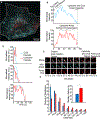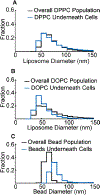A live cell imaging-based assay for tracking particle uptake by clathrin-mediated endocytosis
- PMID: 38971609
- PMCID: PMC11609598
- DOI: 10.1016/bs.mie.2024.02.010
A live cell imaging-based assay for tracking particle uptake by clathrin-mediated endocytosis
Abstract
A popular strategy for therapeutic delivery to cells and tissues is to encapsulate therapeutics inside particles that cells internalize via endocytosis. The efficacy of particle uptake by endocytosis is often studied in bulk using flow cytometry and Western blot analysis and confirmed using confocal microscopy. However, these techniques do not reveal the detailed dynamics of particle internalization and how the inherent heterogeneity of many types of particles may impact their endocytic uptake. Toward addressing these gaps, here we present a live-cell imaging-based method that utilizes total internal reflection fluorescence microscopy to track the uptake of a large ensemble of individual particles in parallel, as they interact with the cellular endocytic machinery. To analyze the resulting data, we employ an open-source tracking algorithm in combination with custom data filters. This analysis reveals the dynamic interactions between particles and endocytic structures, which determine the probability of particle uptake. In particular, our approach can be used to examine how variations in the physical properties of particles (size, targeting, rigidity), as well as heterogeneity within the particle population, impact endocytic uptake. These data impact the design of particles toward more selective and efficient delivery of therapeutics to cells.
Keywords: Clathrin-mediated endocytosis; Colocalization; Drug-carrier internalization; Drug-carrier properties; Endocytosis; Particle tracking; Small unilamellar vesicle.
Copyright © 2024. Published by Elsevier Inc.
Figures







Similar articles
-
Selective Endocytic Uptake of Targeted Liposomes Occurs within a Narrow Range of Liposome Diameters.ACS Appl Mater Interfaces. 2023 Nov 1;15(43):49988-50001. doi: 10.1021/acsami.3c09399. Epub 2023 Oct 20. ACS Appl Mater Interfaces. 2023. PMID: 37862704 Free PMC article.
-
A novel multiple hypothesis based particle tracking method for clathrin mediated endocytosis analysis using fluorescence microscopy.IEEE Trans Image Process. 2014 Apr;23(4):1844-57. doi: 10.1109/TIP.2014.2303633. IEEE Trans Image Process. 2014. PMID: 24808351 Free PMC article.
-
Uptake of Helicobacter pylori vesicles is facilitated by clathrin-dependent and clathrin-independent endocytic pathways.mBio. 2014 May 20;5(3):e00979-14. doi: 10.1128/mBio.00979-14. mBio. 2014. PMID: 24846379 Free PMC article.
-
Systems biology and physical biology of clathrin-mediated endocytosis.Integr Biol (Camb). 2011 Aug;3(8):803-15. doi: 10.1039/c1ib00036e. Epub 2011 Jul 26. Integr Biol (Camb). 2011. PMID: 21792431 Free PMC article. Review.
-
Focusing on clathrin-mediated endocytosis.Biochem J. 2008 Jun 15;412(3):415-23. doi: 10.1042/BJ20080474. Biochem J. 2008. PMID: 18498251 Review.
Cited by
-
Poly-ubiquitylated transmembrane proteins outcompete other cargo for limited space inside clathrin-coated vesicles.bioRxiv [Preprint]. 2024 Dec 18:2024.12.17.628947. doi: 10.1101/2024.12.17.628947. bioRxiv. 2024. PMID: 39763860 Free PMC article. Preprint.
References
-
- Aguet F, Upadhyayula S, Gaudin R, Chou Y, Cocucci E, He K, Chen B-C, Mosaliganti K, Pasham M, Skillern W, Legant WR, Liu T-L, Findlay G, Marino E, Danuser G, Megason S, Betzig E, & Kirchhausen T (2016). Membrane dynamics of dividing cells imaged by lattice light-sheet microscopy. Molecular Biology of the Cell, 27(22), 3418–3435. 10.1091/mbc.E16-03-0164 - DOI - PMC - PubMed
-
- Antonny B, Burd C, De Camilli P, Chen E, Daumke O, Faelber K, Ford M, Frolov VA, Frost A, Hinshaw JE, Kirchhausen T, Kozlov MM, Lenz M, Low HH, McMahon H, Merrifield C, Pollard TD, Robinson PJ, Roux A, & Schmid S (2016). Membrane fission by dynamin: What we know and what we need to know. The EMBO Journal, 35(21), 2270–2284. 10.15252/embj.201694613 - DOI - PMC - PubMed
MeSH terms
Substances
Grants and funding
LinkOut - more resources
Full Text Sources

